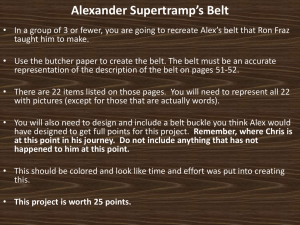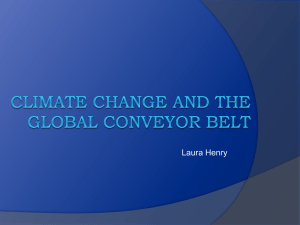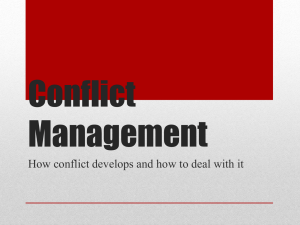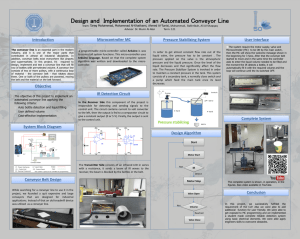PPT - Frac Sand Insider
advertisement
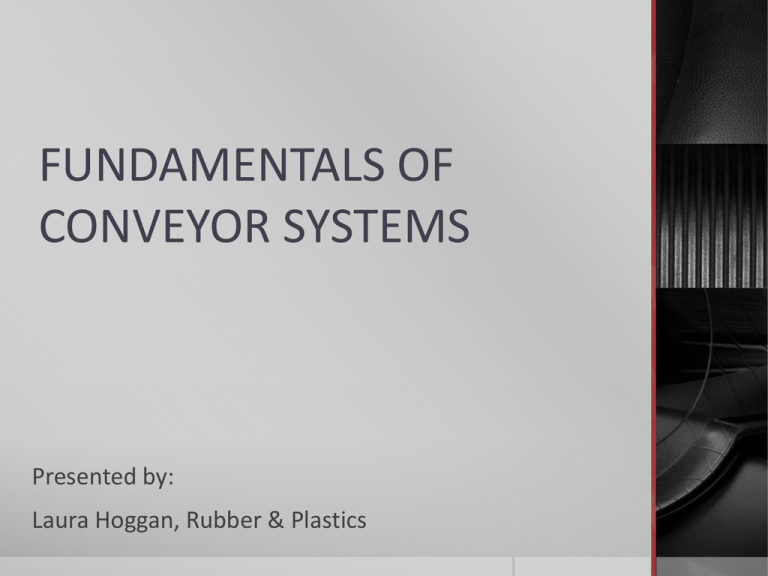
FUNDAMENTALS OF CONVEYOR SYSTEMS Presented by: Laura Hoggan, Rubber & Plastics Topics to be Covered System Maintenance Belt Maintenance Anatomy of a belt Common Frac Sand belt specifications and designs Section I: System Maintenance System Square A conveyor system frame is like a car frame, if your frame is not square it will throw off other components, creating wear and tear. The Dragon Tail is the most susceptible area for being out of square, check it often! Cleaning • Good system maintenance can be summed up in two words, “Good Housekeeping”. • Check pulleys and rollers for material build-up. Loading Area Having the right equipment and a good transaction area is a key component in system life and belt life. Bad Loading can result in: Catastrophic failure Damage to belt Tracking issues TO-DO LIST! Follow OEM guide for lubrication schedule Visually inspect: Rollers, Pulleys, Return rollers & belt guides for excessive wear, built up material and damage. Belt Splice for wear on lace, cracks, missing components. Sidewall for damage and missing sections Inspect belts: Tracking properly Tension Section II: Belt Maintenance Belt Tracking/Training Considerations Conveyor belt moves toward the end of the roller/idler it contacts first Check conveyor system for structural misalignments Check pulleys and idlers for misalignment and material build-up Check belt splice for accuracy and straightness Observe belt in operation empty and loaded for tracking tendencies Eliminate Spillage, Off-center loading and build-up of materials, factors that cause tracking issues Splice Failures Inspect lace to ensure all parts are still present Inspect Vulcanized splices for cracking, splitting and loose sidewall sections Belt Repair Flexco® offers a variety of rip repair fasteners. With these you can patch soft spots before they become rips or a cut or tear in your belt to extend your belt life Eli-Flex rubber repair kits for holes, tears, splits, gouges and excess wear areas SuperScrew patch kits for holes and tears. Provides water tight What happens if I install the wrong belt spec? Belt will wear faster than expected Belt may potentially fail Cleats and/or Sidewall may separate from belt Section III: Anatomy of a belt Belt Specification Breakdown 3 = Number of Tension Plies 2 = Number of Cross Rigid Plies What is a Ply? A rubber coated layer of fabric Each “fabric” layer is a ply Commonly a Polyester/Nylon material Are the strength member of the belt How do you know how many plies you have? Count the number of layers of fabric visible in the belt CROSS RIGID BELT Engineered for applications that take a sharp upturn, with a heavy cleat and/or corrugated sidewall. Cross Rigid belts are rigid across the belt (fill or weft direction) Provides lateral reinforcement that keeps the belting rigid Cross Rigid belting will withstand deflection from horizontal to incline without bowing or sagging during operations. Belt Specification Breakdown 3 = Number of Tension Plies 2 = Number of Cross Rigid Plies 330 = Working tension per inch width Working Tension Working tension is a factor of the fabric/ply Rated on a per inch width Fabric strength has a direct impact on minimum pulley diameter requirements Why does it matter? Belt can snap in operation if not rated for the tension of the system Belt Specification Breakdown 3 = Number of Tension Plies 2 = Number of Cross Rigid Plies 330 = Working tension per inch width 1/8 = Thickness of Rubber top cover Top Cover Thickness Provides an impact and abrasion resistance layer, protecting the belt fabric There are standard cover thicknesses which vary based on the plies and tension rating of the belt Custom thicknesses are available but usually require a minimum quantity purchase Belt Specification Breakdown 3 = Number of Tension Plies 2 = Number of Cross Rigid Plies 330 = Working tension per inch width 1/8 = Thickness of Rubber top cover 1/16 = Thickness of Rubber bottom cover Bottom Cover of a Conveyor Belt May have a rubber bottom or a “bare-back” bottom PVC belts are: COS = Cover one Side CBS = Cover both sides Rubber Belts are: Called out by actual thickness of cover materials What is a “Bare-Back”? A conveyor belt with no bottom rubber cover Bottom of conveyor belt is the fabric from the bottom ply Why use a “Bare-Back”? Slider Bed Applications Fabric bottom has a lower coefficient of friction than a Rubber bottom Belt Specification Breakdown 3 = Number of Tension Plies 2 = Number of Cross Rigid Plies 330 = Working tension per inch width 1/8 = Thickness of Rubber top cover 1/16 = Thickness of Rubber bottom cover MOR / Grd II = The type of Rubber Material used in the belt What Rubber Compounds are common? RMA GRADE 2 MOST COMMON COMPOUND GREAT FOR ALL GENERAL MATERIALS AND PRODUCTS GOOD IMPACT AND ABRASION RESISTANCE RMA GRADE 1 MAINLY FOR HIGH IMPACT, CUTTING AND ABRASION APPLICATIONS MORE NATURAL RUBBER BEST IMPACT, ABRASION AND GOUGE RESISTANCE MOR MAINLY FOR ANY APPLICATION WHERE OILS WILL BE PRESENT. IS MODERATELY RESISTANT TO OILS AND SOLVENTS Section IV: Common Belt Specifications and Designs in Fracking Profile Belts Why use a profile belt? Inclines greater than 20° To prevent roll back of material Common Profiles Herringbone Chevron V-Cleat MaxClimb MegaClimb Frac Sand Belt Configurations Sidewall Belt; No cleats Typically on Sand Delivery Units Sand Delivery Units receive sand transported to the well site. Uses a combination of hoppers and conveyor belts to move frac sand to the T-Belt during fracking operations. Operates on Troughing Idlers Details: Sidewall height from 2” to 4” Available on any belt specification Frac Sand Belt Configurations Narrow Width MaxClimb w/ Sidewall Typically on the T-Belt (Dual Belt Units) Takes discharge from multiple Sand Delivery Units and delivers to the blenders. Compartmented belt allows for high angle discharge of materials. Details: 30” and Narrower belts 1-1/4” tall cleats Sidewall heights of 2” to 6” Frac Sand Belt Configurations MaxClimb w/ Sidewall Typically on the T-Belt (Single Belt Units) Takes discharge from multiple Sand Delivery Units and delivers to the blenders. Compartmented belt allows for high angle discharge of materials. Details: 30” and Wider belts 1-1/4” tall cleats Sidewall heights of 2” to 6” Frac Sand Belt Configurations 3” Peg Belt w/ Sidewall “Peg” or “Finger” Belt Conveys continuous flow of material Powder to moderate lump sizes Up to 45° Angles High material capacity Can be on Delivery Units or T-Belt Units Details: 24” or 30” Wide (Peg pattern is 20”) Available on any belt specification Pegs are 70 durometer Belt End Preparation Super Screw Hot Vulcanized Provides 5x greater adhesion than chemical bonds Prevents product spillage through the splice Mechanical Splice Installed in Factory, no tools needed in field Frack Sand can corrode and wear down metal fasteners that are not protected with a rubber cover. Inspect often to prevent failure! Mechanically fastened to belt Can be installed on one end to expedite field installation Reduces the installation time and tools required How do I know what belt to use? Belt selection is based on; Minimum pulley diameter The configuration of the conveyor system including; Type & Style of return Incline Changes in incline Slider bed or troughed rollers Overall length Height of incline Weight of material Can I change Styles of Frac Belts? For the most part, Yes. Ensure new belt configuration fits the system, checking the following: Sidewall Height Cleat clearances (recess, height, etc.) Belt configuration may alter the speed at which a belt operates to deliver the same tonnage per minute. Frac Sand Environmental Concerns • Small Pulley Diameters • Small pulley diameters put chemical bonds under stress, causing pre-mature failure • Extreme Environments • Extreme cold in South Dakota, Pennsylvania, Canadian markets • Cold temperatures degrade the chemical bond, causing pre-mature failure • Hot vulcanized sidewall is lasting 5x longer than Chemical bonds • Field Location Difficulties • Timeliness to get to breakdown area • Exposure to environment • Potential lack of equipment / power sources How to determine quality of a belt Import vs. Domestic Location of manufacturing doesn’t matter, the quality does. Safety Factors Ply Adhesion Elongation Quality of Value-Add Process; Key term: Hot Vulcanization
